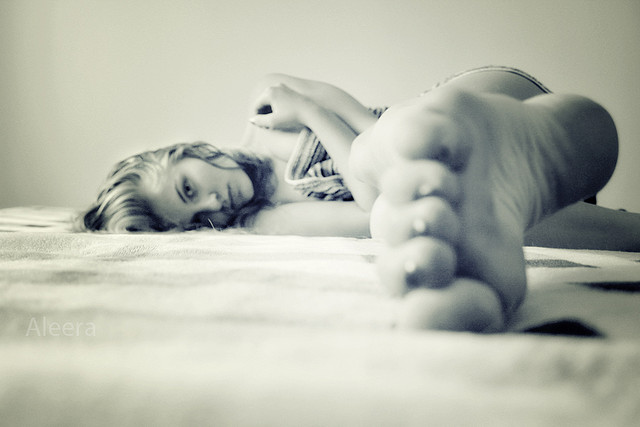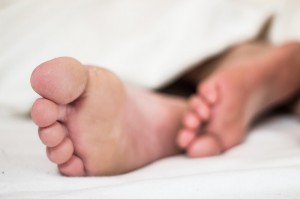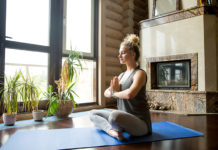Characterized by the strong urges to move your legs, restless legs syndrome (RLS) causes unpleasant and strange feelings when resting or inactive. It is often described as an “itchy” “pins and needles” or “crawling” sensation in the legs. According to the National Heart, Lung, and Blood Institute, between 5% and 15% of Americans are affected by RLS. Moving the legs relieves the unpleasant feelings, but because of the nature of inactivity during the evening and sleeping hours, the syndrome can be particularly heightened.
Many individuals with RLS have a hard time falling asleep and staying asleep. Patients will complain of fatigue and tiredness throughout the day and in turn their daily activities and work can suffer. Not getting enough sleep can lead to other dangerous health concerns like depression and mood swings, among others.
Types of RLS
There are two types of RLS, one that begins before age 45, and the other that starts later in life. Early on-set RLS typically runs in the family. Symptoms normally continue throughout your lifetime and may get worse as you get older. In milder cases, there may be time periods where symptoms disappear temporarily. If your RLS begins at a later age, it tends to be more of an abrupt onset case, which doesn’t run in the family. Symptoms of this later onset type do not typically get worse.
Who Is At Risk
Despite RLS being a syndrome that can affect all ages, races, and ethnicities, some triggers such as medications, diseases, and conditions have been linked to triggering RLS symptoms. According to research posted by the University of Maryland Medical Center, RLS can be a temporary problem associated with other conditions such as pregnancy, ADHD, and those undergoing kidney dialysis. Many of the symptoms of temporary RLS are related to deficiencies/imbalances of certain chemicals in the body.
While pregnant or on dialysis it is common for individuals to have low iron levels that can contribute to RLS symptoms. Patients with ADHD have shown evidence of linkages between RLS and Periodic Limb Movement Disorder (PLMD) that may be caused by a deficiency in the brain chemical, dopamine.
Other Potential Causes & Risk Factors
- Nerve damage, such as peripheral neuropathy, may worsen symptoms of RLS.
- Medications: anti-nausea, antidepressants, antipsychotics, and calcium channel blockers (used to treat heart conditions and hypertension).
- Alcohol & tobacco use can increase RLS symptoms or trigger them.
- Symptoms may improve if substances are stopped.
How Are Restless Legs Treated?
Treatment for RLS can be a variety of methods, from medications to lifestyle changes. Individuals with iron deficiencies can be treated with supplements to help them boost iron levels. Physicians may also recommend medications to help ease RLS symptoms. These medications include muscle relaxants or sleep aids, opioids, and epilepsy treatment medications such as Neurontin. Prescriptions have many potential side effects and do not address the underlying cause(s). They are meant to treat the symptoms but do not take a look at the holistic and natural ways to help ease, or prevent, RLS.
Restless Leg Syndrome Home Remedies
1. Lifestyle changes
Due to the underlying conditions that could cause RLS such as obesity, diabetes, and kidney disease, a great starting place is to take a hard look at the lifestyle choices that we make everyday. By making changes in the diet to include more whole foods, fruits, and vegetables without additives, preservatives, and high sugar or sodium, the body is able to process better and detoxify. Drink plenty of water and avoid alcohol and tobacco, which can trigger or make symptoms of RLS worsen. Before making major changes to your diet, always consult your family physician first.
2. The Right Supplements..Give Your Body What It Needs!
In addition to lifestyle changes, the following two supplements, working synergistically together, have helped many of my patients with RLS:
- Foundation Vitamin Formula has a well-balanced amount of vitamins and minerals which help to maintain the body’s optimal performance. This high-grade, professional formula replaces and balances vitamins and minerals at the cellular level.
- Chelated Magnesium helps many improve, or resolve, their RLS. I recommend 2 at bedtime. This may be increased to 2 twice a day if needed. Magnesium is an important mineral, responsible for over 300 enzyme reactions, and can be found in all of your tissues. About 80% of us are deficient in magnesium. This is due to soil nutrient depletion, and can be compounded by poor food choices. The food you eat today does not have the same amount of magnesium ( any many other nutrients) as it did 50 years ago. Please keep in mind that serum blood tests will often be reported as normal. Don’t be mislead by a normal blood serum magnesium level. The best way to evaluate magnesium levels is by testing the levels in white blood cells (WBCs). However, since the vast majority of us are deficient, replacement with the proper supplement and dose is the most popular way to go. The single most effective method of improving, or resolving, RLS in my patients has been through using chelated magnesium. It is completely absorbed, and works at the cellular level to attain natural muscle relaxation. There are many forms (and qualities) of magnesium supplements on the market. In my experience, most do not raise tissue levels enough to get the desired results.
3. Symptom Relief
RLS symptoms may continue even with the daily supplement and lifestyle changes. Learning to handle the symptoms naturally can help to relieve pain and stress. Activities that can provide relief include:
- Walking and stretching
- Hot Epsom salts baths
- Massaging the affected limb
- Hot or cold packs on affected limbs
Making conscience decisions to move around when you know you may be stationary for a while can also help to relieve symptoms. Choose an aisle seat at the movies, or during a lengthy plane ride as you may have the urge to get up and walk around.
4. Good Sleep Habits
Due to the increased symptoms during times of rest, it is important to give yourself the best chance for the most restful night’s sleep possible. Adopting some of these good sleep habits can improve the time it takes for you to fall asleep and stay asleep.
- Keep your bedroom cool, quiet, comfortable, and as dark as possible.
- Remove distractions that may prevent or interrupt sleep such as televisions, phones, and computers.
- Get a routine down, with the same time you sleep and awaken each day.
- Try to avoid long periods of being stationary in bed, while lying awake in the evening or night.
Relaxation methods such as meditation, yoga, or reading can be a good way to wind down and prepare your body for rest. Challenging activities such as crossword puzzles can also ease RLS symptoms. I recommend regular, moderate exercise to help keep the body fit, healthy, and prepared for rest. Many people find that if they’re active throughout the day, then their symptoms lessen in the evening.









